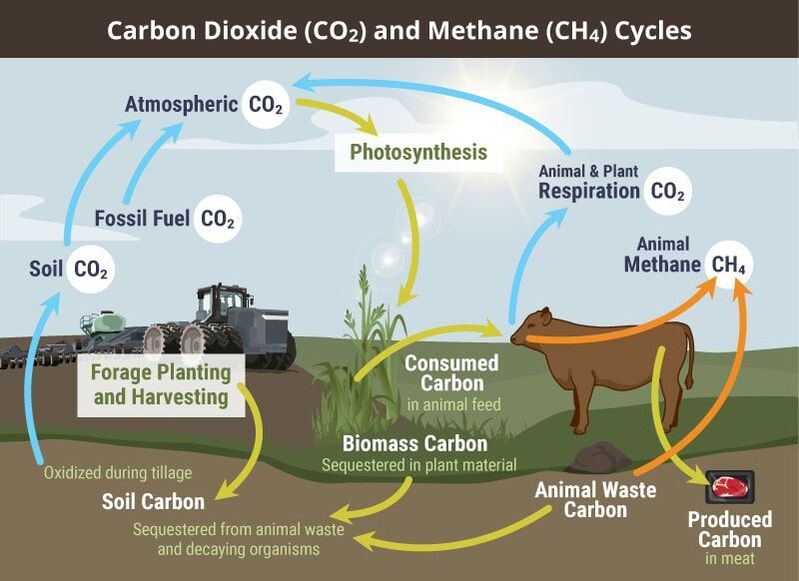|
Regenerative animal husbandry, particularly in the form of pasture-raised or grass-fed livestock management, stands out as a promising solution to offset carbon emissions. This sustainable farming approach not only prioritizes the welfare of animals but also plays a crucial role in enhancing the health of large grasslands. Let's delve into how regenerative animal husbandry contributes to carbon offset through strategic grassland management. carbon sequestrationThe extensive root systems of perennial grasses act as effective carbon sinks. When animals graze on these grasses, their natural behaviors stimulate root growth, facilitating enhanced carbon sequestration in the soil. One of the most significant environmental advantages of regenerative practices lies in their ability to enrich soil carbon. As animals graze on perennial grasses, their interaction with the soil enhances carbon sequestration. This not only improves soil fertility but also aids in combating climate change by locking carbon away in the ground. Soil healthLivestock contribute to nutrient cycling and organic matter in the soil through grazing. This enhances soil structure and fertility, creating an environment conducive to carbon storage and promoting overall soil health. holistic grazing methodsRegenerative practices, such as rotational grazing systems, prevent overgrazing and allow grasses to recover. This not only promotes healthier plant growth but also contributes to increased carbon sequestration. biodiversity enhancementWell-managed pasture systems support biodiversity by creating habitats for various plant and animal species. Biodiverse ecosystems are more resilient to environmental changes, contributing to the overall health of the grassland. Regenerative animal husbandry actively contributes to building resilient ecosystems. By promoting biodiversity, these practices create a harmonious environment where different plant and animal species thrive. The interconnectedness of diverse life forms establishes a robust ecosystem that is better equipped to adapt to environmental changes. reduced inputsRegenerative systems prioritize minimizing the use of synthetic fertilizers and pesticides, unlike conventional mono-crop agricultural practices. By doing so, they reduce the carbon footprint associated with the production and application of these inputs, promoting a more sustainable approach. This shift away from chemical-intensive methods benefits both the land and surrounding ecosystems. methane mitigationCertain regenerative practices, like rotational grazing on diverse forages, enhance the digestive efficiency of ruminant animals. This may result in reduced methane emissions, contributing to methane mitigation efforts. water managementThe impact of regenerative practices extends to water management. Healthy grasslands with well-managed vegetation improve water infiltration into the soil. This not only reduces the risk of runoff and erosion but also preserves water quality, supporting the overall health of the ecosystem. Such water conservation measures play a vital role in sustaining local ecosystems and supporting communities. restoration of degraded landRegenerative animal husbandry can be applied to restore degraded or abandoned lands, converting them into productive and resilient grasslands that sequester carbon over time. By applying holistic management techniques, farmers can convert these areas into thriving grasslands that sequester carbon over time - dirt into soil. This restoration not only benefits the environment but also revitalizes the landscape. community and economic benefitsSupporting regenerative practices doesn't just benefit the environment; it has a positive ripple effect contributing to the economic sustainability of local economies. By fostering connections between consumers and producers, these practices create economic sustainability within communities. This model encourages responsible land stewardship and promotes a sense of shared responsibility for the environment.
Regenerative animal husbandry, especially in pasture-raised systems, offers a holistic and sustainable approach to managing large grasslands. By focusing on soil health, biodiversity, and thoughtful grazing management, these practices contribute to carbon sequestration, mitigate methane emissions, and promote the overall resilience of ecosystems. As we face the challenges of climate change, harnessing the power of regenerative animal husbandry emerges as a vital strategy for a more sustainable and balanced future.
0 Comments
Forming community with like-minded people has never been more important . . . and it has never been more difficult. As the gatekeepers of our increasingly disconnected world try to close the door on our various options for finding community, today James explores some ways to meet sane people in your area, from the technological to the old-fashioned.
As humanity enters the second decade of the 21st century, we find ourselves at the precipice of a Technocratic Age where Artificial Intelligence (AI), Smart Technology, and the Internet of Things are becoming a part of everyday life. This technology provides benefits but comes at a cost--corporations, governments, law enforcement, and hackers are all capable of peering into our lives at any moment. Corporations and governments are even learning to use technology in a way that allows them to be the "social engineers" of society. The concept of social credit is also becoming increasingly popular, and the likelihood that citizens will face negative consequences for choosing to speak about controversial topics or criticizing authorities is only going to increase.
In his new book, author Derrick Broze examines the current push towards smart grid technology and explores the concept of Technocracy. Is this obscure political theory from the 20th century the guiding force behind the move towards a digital dystopia? What are the implications for a world that is always plugged in and on "the grid"? How can one maintain privacy and liberty in a society that is based on mass surveillance, technological control, and the loss of individuality? Broze believes the answers to our problems can be found in the work of political philosopher Samuel E. Konkin, and what he termed, Counter-Economics. Konkin outlined a specific strategy and mentality that encouraged "opting out" of the State's economic system, as well as any other system that does not align with one's values. By understanding the importance of Konkin's ideas it may be possible to adapt them to our digital world and forge a path towards liberty, privacy, and equality. Do you want to understand the philosophy which guides our digital world? Are you looking for practical solutions to maintain privacy and liberty? It is time to learn how to opt-out of the Technocratic State.
Derrick Broze of TheConsciousResistance.com joins us today to provide an update on the counter-economic underground railroad which we discussed last year. The first group has crossed the border and more people than ever are looking to escape the Collapsing States of America and finding freedom elsewhere. We discuss the exit and build strategy, Freedom Cells, and how you can find out more about the growing number of people who are looking to start communities of purpose.
Agrarianism is a socio-economic and political philosophy that places a significant emphasis on agriculture, rural life, and the well-being of farming communities. The term is derived from the Latin word "ager," which means "field" or "land." Agrarianism advocates for the importance of agriculture as the foundation of a healthy and sustainable society.
Agrarianism promotes countryside living over an urbanized lifestyle. It is a rejection of capitalism which it sees as damaging to rural and farming communities. Instead it advocates for these communities to be more self-sufficient living off local and sustainable produce. It's origins lie within a 19th century European movement which gave voice to peasants and farmers during the period of Industrial Revolution. In the 21st century however Agrarians favored decentralization of government, the promotion of traditional values, and fair rights in pay for farmers and farm workers. Key principles of agrarianism include:
Agrarianism has influenced various movements throughout history, including populist movements, environmentalism, and critiques of modern industrial society. It continues to shape discussions about sustainable agriculture, rural development, and the balance between technological progress and environmental stewardship. Our ancestors have used mushrooms as medicine for thousands of years. The Greek physician Hippocrates, 450 BCE, classified the amadou mushroom (Fomes fomentarius) as a potent anti-inflammatory and for cauterizing wounds. Although mushrooms have long been used by various cultures, only recently has modern science rediscovered what the ancients knew long ago—that mushrooms can be deep reservoirs of powerful medicines (Stamets & Zwickey, 2014). Indeed, it is well established that both the human population and Mother Earth could benefit from the existence of mushrooms which could one day save the world. From fulfilling our macro-nutrient needs to increasing our immune system in order to fight off viruses & diseases (Stamets, 2009; 2012). Some mushrooms, however, are now under clinical trials due to their mind altering effects which has the potential to cure a number of mental health disorders such as depression, addiction, and anxiety with many more results soon to come. And as long as there are organizations who are allowed to study any psychedelics with medicinal uses, then it could very possibly be that they have been part of our evolution for thousands of years (Jr, 2017; Mcrae, 2017; Thomas, Malcolm & Lastra, 2017). The benefits of mycelium to our planet Mycelium is the roots of white fuzzy threads or network where mushrooms spawn. Paul Stamets has briefly explained on Fungi the impact mycelium has on our ecology Four components of mycorestoration are described in detail:
These hardwood dowels, or “plug spawn”, have been inoculated with a single species of fungi. Plug spawn is used to inoculate a fresh cut log to encourage the growth and fruiting of a specific species of edible and/or medicinal mushroom. Plug spawn can be stored in the refrigerator for up to 4-6 months before use. Log Preparation
Log Incubation period
Log Fruiting Cycle After the incubation period, logs can be soaked to force a fruiting. Soaking Method
References Ballroom, Jr. (2017). Psychedelic Science 2017, Psilocybin Mushrooms and The Mycology of Consciousness. Retrieved 01/16/2019 from http://psychedelicscience.org/conference/interdisciplinary/psilocybin-mushrooms-and-the-mycology-of-consciousness
Mcrae, M. (2017). Science Alert, Research Shows Magic Mushrooms Can Offer Real Benefits in Depression Therapy. Retrieved 01/16/2019 from https://www.sciencealert.com/therapy-for-depression-gets-a-significant-boost-when-combined-with-psilocybin Stamets, P. (2005). Mycellium running. Berkeley, California,: Ten Speed Press. Stamets, P. (2009). Fungi Perfecti, The Search for Agarikon. Retrieved 01/16/2019 from http://www.fungi.com/blog/items/the-search-for-agarikon.html Stamets, P. (2012). The Blog, Agarikon: Ancient Mushroom for Modern Medicine. Retrieved 01/16/2019 from https://www.huffingtonpost.com/paul-stamets/agarikon-mushroom_b_1861947.html Stamets, P., & Zwickey, H. (2014). Medicinal Mushrooms: Ancient Remedies Meet Modern Science. Integrative medicine (Encinitas, Calif.), 13(1), 46-7. Retrieved 01/16/2019 from https://www.ncbi.nlm.nih.gov/pmc/articles/PMC4684114/pdf/46-47.pdf Thomas, K., Malcolm, B. and Lastra, D. (2017). Psilocybin-Assisted Therapy: A Review of a Novel Treatment for Psychiatric Disorders. Journal of Psychoactive Drugs. [online] 59(5), pp.446-455. Available at https://dx.doi.org/10.1080/02791072.2017.1320734 [Accessed 16 Jan. 2019] Dunbar's number is a suggested cognitive limit to the number of people with whom one can maintain stable social relationships—relationships in which an individual knows who each person is and how each person relates to every other person. This number was first proposed in the 1990s by British anthropologist Robin Dunbar, who found a correlation between primate brain size and average social group size. By using the average human brain size and extrapolating from the results of primates, he proposed that humans can comfortably maintain only 150 stable relationships.
Dunbar is an anthropologist at the University College of London, who wrote a paper on Co-Evolution Of Neocortex Size, Group Size And Language In Humans where he hypothesizes: ... there is a cognitive limit to the number of individuals with whom any one person can maintain stable relationships, that this limit is a direct function of relative neocortex size, and that this in turn limits group size ... the limit imposed by neocortical processing capacity is simply on the number of individuals with whom a stable inter-personal relationship can be maintained. Dunbar supports this hypothesis through studies by a number of field anthropologists. These studies measure the group size of a variety of different primates; Dunbar then correlate those group sizes to the brain sizes of the primates to produce a mathematical formula for how the two correspond. Using his formula, which is based on 36 primates, he predicts that 147.8 is the "mean group size" for humans, which matches census data on various village and tribe sizes in many cultures. People are isolated from each other, public spaces are being privatized, and we are being punished for attempting to grow our own food. There is only one solution: resistance. Join James for this classic Corbett Report episode where he explores how to build communities through revolutionary gardening, revolutionary walking and other everyday activities.
|
This feed contains research, news, information, observations, and ideas at the level of the community.
Archives
June 2024
Categories
All
|




 RSS Feed
RSS Feed

